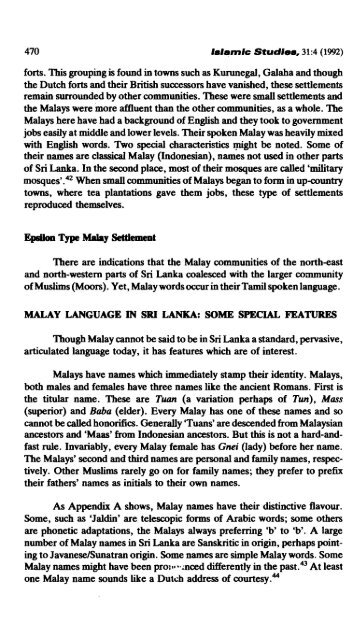MALAY LANGUAGE IN SRI LANKA: SOCIO-MECHANICS OF A ...
MALAY LANGUAGE IN SRI LANKA: SOCIO-MECHANICS OF A ...
MALAY LANGUAGE IN SRI LANKA: SOCIO-MECHANICS OF A ...
Create successful ePaper yourself
Turn your PDF publications into a flip-book with our unique Google optimized e-Paper software.
470 Islamic Studies, 31:4 (1992)<br />
forts. This grouping is found in towns such as Kurunegal, Galaha and though<br />
the Dutch forts and their British successors have vanished, these settlements<br />
remain surrounded by other communities. These were small settlements and<br />
the Malays were more aMuent than the other communities, as a whole. The<br />
Malays here have had a background of English and they took to government<br />
jobs easily at middle and lower levels. Their spoken Malay was heavily mixed<br />
with English words. Two special characteristics rpight be noted. Some of<br />
their names are classical Malay (Indonesian), names not used in other parts<br />
of Sri Lanka. In the second place, most of their mosques are called 'military<br />
mosques'." When small communities of Malays began to form in up-country<br />
towns, where tea plantations gave them jobs, these type of settlements<br />
reproduced themselves.<br />
Epsiron Type Malay Settlement<br />
There are indications that the Malay communities of the north-east<br />
and north-western parts of Sri Lanka coalesced with the larger community<br />
of Muslims (Moors). Yet, Malay words occur in their Tamil spoken language.<br />
<strong>MALAY</strong> <strong>LANGUAGE</strong> <strong>IN</strong> <strong>SRI</strong> <strong>LANKA</strong>: SOME SPECIAL FEATURES<br />
Though Malay cannot be said to be in Sri Lanka a standard, pervasive,<br />
articulated language today, it has features which are of interest.<br />
Malays have names which immediately stamp their identity. Malays,<br />
both males and females have three names like the ancient Romans. First is<br />
the titular name. These are Tuan (a variation perhaps of Tun), Mass<br />
(superior) and Baba (elder). Every Malay has one of these names and so<br />
cannot be called honorifics. Generally 'Tuans' are descended from Malaysian<br />
ancestors and 'Maas' from Indonesian ancestors. But this is not a hard-and-<br />
fast rule. Invariably, every Malay female has Gnei (lady) before her name.<br />
The Malays' second and third names are personal and family names, respec-<br />
tively. Other Muslims rarely go on for family names; they prefer to prefix<br />
their fathers' names as initials to their own names.<br />
As Appendix A shows, Malay names have their distinctive flavour.<br />
Some, such as 'Jaldin' are telescopic forms of Arabic words; some others<br />
are phonetic adaptations, the Malays always preferring 'b' to 'b'. A large<br />
number of Malay names in Sri Lanka are Sanskritic in origin, perhaps pointing<br />
to JavaneseISunatran origin. Some names are simple Malay words. Some<br />
Malay names might have been prou#-.-nced differently in the past." At least<br />
one Malay name sounds like a Dutch address of courtesy.44
















